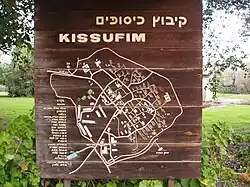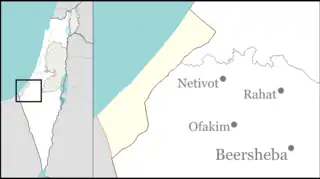Kissufim
כִּסּוּפִים كيسوفيم | |
|---|---|
 Map of Kissufim on a sign in the kibbutz. | |
| Etymology: Yearning | |
 Kissufim  Kissufim | |
| Coordinates: 31°22′27″N 34°23′58″E / 31.37417°N 34.39944°E | |
| Country | |
| District | Southern |
| Council | Eshkol |
| Affiliation | Kibbutz Movement |
| Founded | 1951 |
| Founded by | American and South American Zionist youth movement members |
| Population (2021)[1] | 292 |
| Website | www |
Kissufim (Hebrew: כִּסּוּפִים, lit. 'Yearning') is a kibbutz in the northwestern Negev desert in Israel. Located adjacent to the Gaza Strip at an altitude of 92 meters above sea level, it falls under the jurisdiction of Eshkol Regional Council. In 2021 it had a population of 292.[1]
History
The village was established in 1951 by Zionist youth movement members from the United States and South America. One of the founders of the kibbutz was Ami Saull, who was born in Manhattan 1932 (nephew of Israel Galili and father of filmmaker Dror Shaul). Kissufim is part of the Shalom bloc of Israeli settlement meant to secure Israel's southern border with the Gaza Strip from the numerous Palestinian Fedayeen infiltrations. The government financed reinforced concrete rooms for each home which serve as bomb shelters.[2]
In 1999, Dror Shaul, who was born and raised on Kissufim, filmed a satirical comedy, Operation Grandma, based on life in the kibbutz.[3]
During the 2023 Kissufim massacre, 8 residents and 6 foreign workers were murdered in the kibbutz.
Economy
The kibbutz economy relies on dairy farming, poultry farming, citrus groves and an avocado orchard which constitutes one of the kibbutz's primary sources of income. Kissufim had a factory that produced plastic frames for eyeglasses[4] The Kissufim dairy has 380 cows with an average milk production of 12,800 liters.[5]
Archaeology
Tell Jemmeh is a major archaeological site located about 5 kilometers east-northeast of Kissufim, on the southern bank of HaBesor Stream. In June 1977, a tractor-driver preparing a new field discovered mosaics believed to be part of the floor of a mid-sixth century Byzantine church. According to archaeologists it was built on the plan of an early Christian basilica during the reign of Constantine in 313 C.E.[6]
Kibbutz Kissufim houses an archaeology museum showcasing artifacts discovered the area.
Kissufim crossing
The nearby crossing into the Gaza Strip, named for the kibbutz, was the main route for traffic into the Gush Katif Israeli settlement bloc. It was permanently closed to inbound Israeli civilian traffic on 15 August 2005 as part of the disengagement plan. The last Israeli soldier left the Gaza strip and closed the gate at dawn of 12 September 2005, completing the Israeli withdrawal from the Gaza Strip.[7]
Notable people
- Avihu Medina, composer, arranger, songwriter and singer
- Dror Shaul, filmmaker
References
- 1 2 "Regional Statistics". Israel Central Bureau of Statistics. Retrieved 22 February 2023.
- ↑ The safest room in the house
- ↑ Ready, Set, Action: 16 Israeli Cult Movies to Feel Like a Local
- ↑ Israel High-tech and investment report
- ↑ Israeli dairy farmers slaughtered by Hamas as they milked their cows
- ↑ The Marvelous Mosaics of Kissufim
- ↑ Israel completes Gaza withdrawal BBC News, 12 September 2006
External links
- Official website (in Hebrew)
- Kissufim Negev Information Centre
- 15-minute movie on Kissufim in the 1950s Steven Spielberg Jewish Film Archive
- Kissufim Archived 2011-07-23 at the Wayback Machine Bo HaBayta article
Archaeology links
- Cohen, Rudolph (January–February 1980). "The Marvelous Mosaics of Kissufim". Biblical Archaeology Review. Retrieved 2019-10-04.
- Cohen, Rudolph (1993-06-01). "A Byzantine church and its mosaic floors at Kissufim". In Tsafrir, Yoram (ed.). Ancient Churches Revealed. Jerusalem: Israel Exploration Society. pp. 277–282. ISBN 9789652210166.
- Ronen, Avraham; Gilead, D.; Shachnai, E.; Saull, Ami (1972-02-15). "Upper Acheulean in the Kissufim Region". Proceedings of the American Philosophical Society. 116 (1): 68–96. JSTOR 985707. Regarding Early Paleolithic flint tools of Acheulean technology in the Kissufim museum.